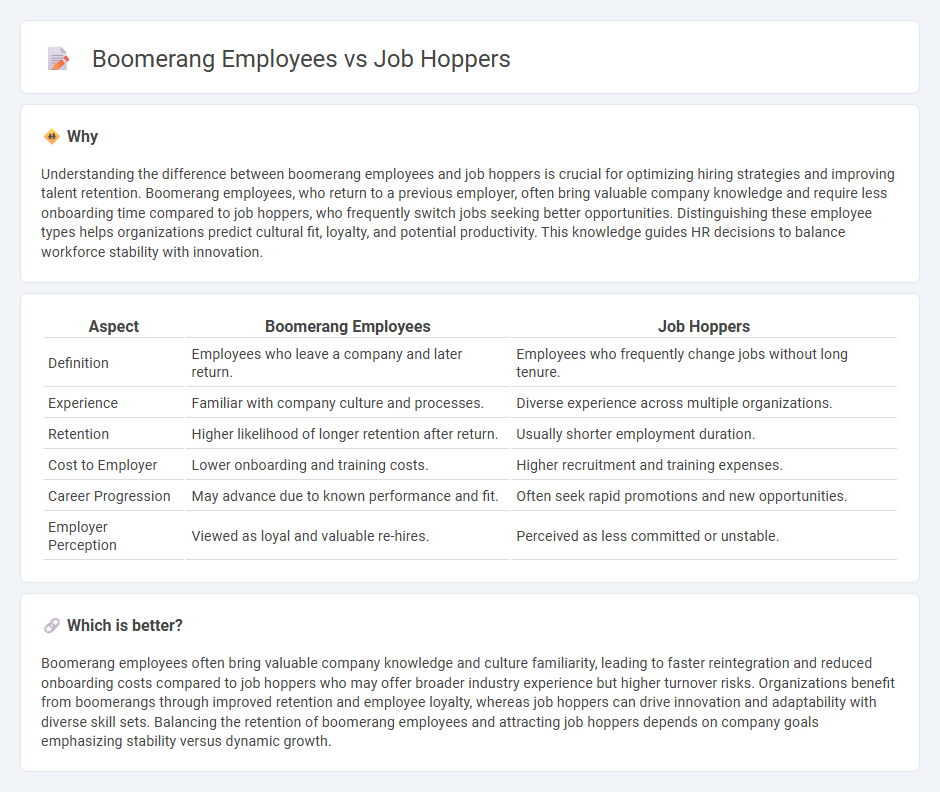
Boomerang employees bring valuable institutional knowledge and proven loyalty, often resulting in faster onboarding and higher retention rates compared to job hoppers who seek frequent career changes for diverse experiences and rapid salary growth. Companies leveraging boomerang hires can reduce recruitment costs and strengthen team dynamics, while job hoppers may accelerate innovation through varied skill sets and fresh perspectives. Explore the strategic benefits and challenges of each employment trend to optimize your talent management approach.
Why it is important
Understanding the difference between boomerang employees and job hoppers is crucial for optimizing hiring strategies and improving talent retention. Boomerang employees, who return to a previous employer, often bring valuable company knowledge and require less onboarding time compared to job hoppers, who frequently switch jobs seeking better opportunities. Distinguishing these employee types helps organizations predict cultural fit, loyalty, and potential productivity. This knowledge guides HR decisions to balance workforce stability with innovation.
Comparison Table
| Aspect | Boomerang Employees | Job Hoppers |
|---|---|---|
| Definition | Employees who leave a company and later return. | Employees who frequently change jobs without long tenure. |
| Experience | Familiar with company culture and processes. | Diverse experience across multiple organizations. |
| Retention | Higher likelihood of longer retention after return. | Usually shorter employment duration. |
| Cost to Employer | Lower onboarding and training costs. | Higher recruitment and training expenses. |
| Career Progression | May advance due to known performance and fit. | Often seek rapid promotions and new opportunities. |
| Employer Perception | Viewed as loyal and valuable re-hires. | Perceived as less committed or unstable. |
Which is better?
Boomerang employees often bring valuable company knowledge and culture familiarity, leading to faster reintegration and reduced onboarding costs compared to job hoppers who may offer broader industry experience but higher turnover risks. Organizations benefit from boomerangs through improved retention and employee loyalty, whereas job hoppers can drive innovation and adaptability with diverse skill sets. Balancing the retention of boomerang employees and attracting job hoppers depends on company goals emphasizing stability versus dynamic growth.
Connection
Boomerang employees and job hoppers share a dynamic relationship within employment trends, both reflecting evolving workforce mobility. Boomerang employees, who return to a former employer, often leverage experiences gained through job hopping to bring enhanced skills and fresh perspectives. Job hoppers, by continuously seeking new roles, contribute to a talent pool where organizations increasingly value rehires for adaptability and diverse expertise.
Key Terms
Retention
Job hoppers frequently switch employers seeking varied experiences and higher salaries, often leading to increased turnover rates and recruitment costs for companies. Boomerang employees, who return to a previous employer, offer enhanced retention benefits by bringing organizational knowledge and quicker reintegration compared to new hires. Explore how leveraging boomerang employees can strengthen retention strategies and optimize workforce stability.
Turnover
Job hoppers typically exhibit higher turnover rates due to frequent changes in roles aiming for career advancement, whereas boomerang employees often return to previous employers, bringing back valuable experience and reducing onboarding time. Studies show that boomerang employees tend to have lower turnover rates compared to traditional new hires, improving overall retention and company stability. Discover how leveraging boomerang talent can optimize your workforce strategy.
Rehire
Job hoppers frequently switch roles and companies, often raising concerns about loyalty and long-term commitment, which can affect rehire eligibility. Boomerang employees, on the other hand, return to a previous employer, typically bringing valuable institutional knowledge and proven performance that enhance their rehire prospects. To explore the strategic advantages of rehiring boomerang employees versus hiring job hoppers, discover more insights here.
Source and External Links
Job Hopping | What is it and what are its advantages? - Iberdrola - Job hoppers frequently change jobs voluntarily seeking new challenges and opportunities to grow skills, valued for their resilience, communication, and continual self-improvement in the modern labor market.
Job Hopper Meaning & Definition - hireful.com - Job hoppers change jobs every 6-18 months, gaining career advancement faster through new roles and building extensive professional networks, although they may face difficulties due to perceived job instability.
Job Hoppers - Indeed - Job hoppers tend to have high ambition and adaptability, quickly learning new skills across various workplaces and potentially motivating teams and helping businesses stay agile.
 dowidth.com
dowidth.com